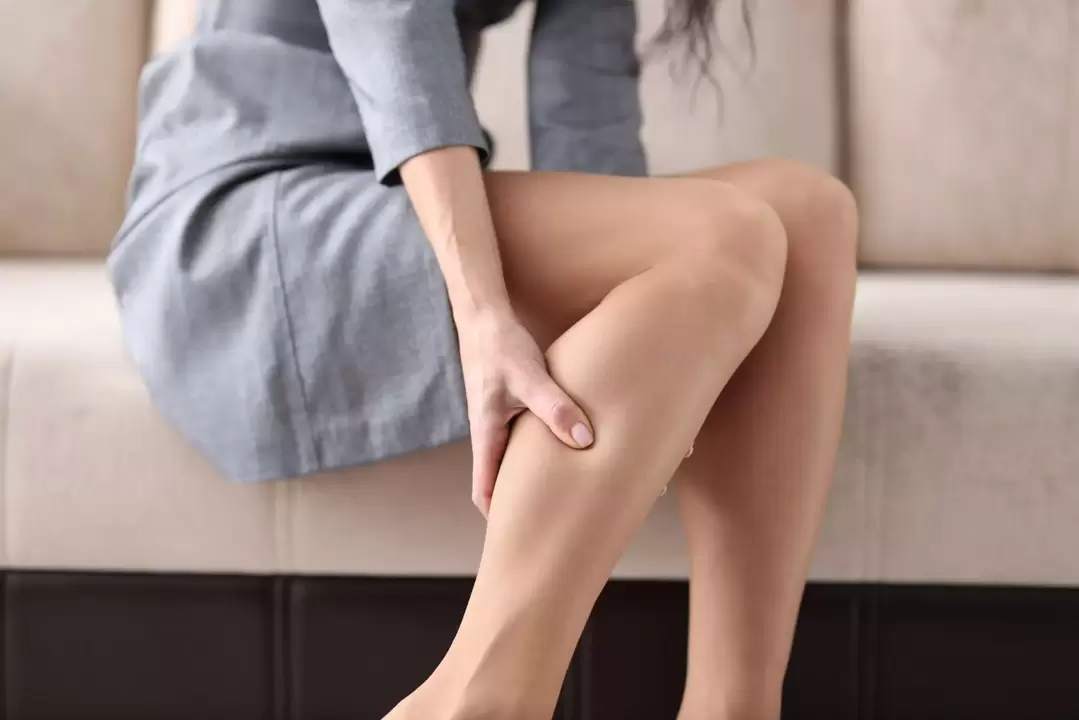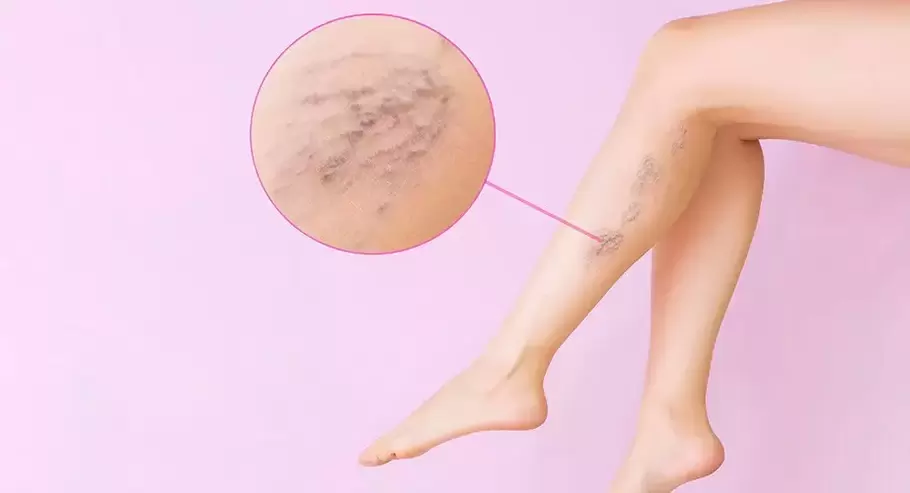Varicose veins are a disease of the subcutaneous veins, which is expressed in their excessive expansion and stretching, the elasticity of the veins is lost, the blood circulation process is disturbed. Swollen varicose veins usually appear on the legs.
Varicose veins are considered a cosmetic problem, but if left untreated, they can lead to complications. The main ones are trophic ulcers and thrombophlebitis, which develop in 70% of patients with varicose veins.
Symptoms of varicose veins
Signs that appear in the initial stages:
- legs get tired quickly;
- burning and heaviness in the legs;
- small swellings appear;
- there is pain in the veins;
- has calf cramps.
Another characteristic sign of varicose veins is the localization of pain in the calves, which appears in the evening and disappears in the morning. The pain is not sharp, the sensations are moderate, pulling.
In the first stages, varicose veins are not visible, but varicose veins are already developing. Sometimes it takes decades. Gradually, the symptoms become more and more alarming, signs of venous insufficiency appear:
- swelling of the legs - in patients (most often these are women who suffer from varicose veins), chronic vein disease is usually accompanied by an increase in the volume of the lower leg. At the same time, swelling, as well as pain and heaviness, are observed in the afternoon and subside after sleep. Swelling of the legs is not typical of the mentioned pathology, it is a symptom of lymphedema;
- skin itching;
- knots, curves that are visible to the naked eye;
- darkening, thickening of the skin, the appearance of a bluish tint.
As the venous disease progresses, the symptoms intensify. There is a deterioration in the appearance of the skin of the legs, eczema and trophic ulcers appear.

Causes of varicose veins
The cause of varicose veins is the insufficiency of the venous valves of the legs, due to which the outflow of blood worsens. The venous network of the legs consists of superficial and deep veins connected by vessels. Superficial veins carry blood away from the skin and subcutaneous structures, while deep veins carry it away from internal organs. The veins that connect them act as compensators that equalize the pressure in the superficial and deep vessels.
The correct blood flow passes in the direction from the superficial veins to the deep ones. This direction can be ensured by the movement of the surrounding muscles and the work of the vasomotor center, since the movement from the bottom up opposes the forces of attraction.
If for some reason the outflow becomes difficult, the wall of the vessels becomes inflamed, thinned, varicose veins and cyanotic nodes characteristic of varicose veins appear.
The disease develops as a response to a complex of unfavorable conditions indicated below:
- heredity - the weakness of the walls of blood vessels can be passed from generation to generation and lead to a loss of vascular tone;
- exhausting work, standing - a high-risk group includes people who, by the nature of their work, have to sit or stand for a long time;
- frequent pregnancies and childbirth - during this period, the total volume of blood increases and the pressure on the veins increases, which provokes varicose veins;
- obesity - increased venous pressure in overweight people increases the chance of varicose veins;
- malfunction in the hormonal system - self-administration of contraceptives and other hormone-based drugs causes changes in the venous wall. In women, such a reaction can be observed during pregnancy;
- nutrition - the lack of fresh fruits and vegetables in the menu leads to a lack of fiber, as a result - weakening of the venous wall.
What do varicose veins look like?
Since varicose veins are a modification of the veins, the disease is also called a cosmetic problem:
- first, patients notice the appearance of webs and a venous pattern on their legs;
- later the veins become tortuous, lifting the skin;
- in the most advanced stages, varicose nodes are clearly visible, representing the expansion and intertwining of blood vessels.
What is the danger of the disease
What happens if the disease is not treated? It will inevitably lead to complications. The most dangerous are thrombophlebitis and the "separation" of a blood clot. 5% of all patients experience such complications. With age, a trophic ulcer often forms, which is difficult to treat. The risk of complications from varicose veins increases with time.
thrombophlebitis . With it, blood clots form in the veins of the legs, which can break off and block the arteries, leading to a myocardial infarction.Venous thrombosis. Blockage of a vessel by a blood clot. It is manifested by pain in the legs, which increases with physical effort.Pulmonary embolism . Obstruction of its lumen by a separate thrombus. Death may occur within the first half hour. If the clot is small, then a pulmonary infarction may occur.Trophic ulcers. Darkening and thinning of the skin with further ulceration. It occurs as a result of tissue malnutrition. Poor response to treatment.
Risk factors
Heredity . If both parents have varicose veins, then the probability of a child getting sick is 90%, if one has 60%.Pregnancy During this period, vein disease is provoked by 3 factors:- hormonal change - the production of progesterone in large quantities relaxes the muscles, makes the veins more vulnerable;
- pressure of the uterus, which has increased in size - in connection with this, the outflow of blood from the legs worsens;
- increase in blood volume by 20-30% - the venous valves of the legs cannot withstand the load, especially if they were initially weak;
Improper nutrition. Uncontrolled consumption of processed foods, sugar and salt, fast food, fried and fatty foods, trans fats, preservatives and artificial additives from industrial products also leave their mark.Hormonal background. The activity of hormones can weaken the veins, which provokes vasodilation and prevents the valves from closing normally.Tight clothes . Tight belts, tight jeans and underwear interfere with the harmonious flow of blood, making circulation difficult.High heels . When walking, the veins work to their limit. This is due to the fact that the load is distributed unevenly - the main share falls on the front of the leg. Pain in the veins, swelling of the legs are the first signs of starting varicose veins.

Diagnosis of varicose veins
Ultrasound technologies - angioscanning and dopplerography - are used in the early diagnosis of varicose veins.
Ultrasound angioscanning (USAS) is an informative method for non-invasive examination of peripheral vessels. This makes it possible to obtain a two-dimensional image of the artery, visualize intravascular structures, and assess the direction and nature of fluid flow.
In severe cases where no response can be obtained with USAS, computed tomography (CT) is used.
Doppler ultrasound (Doppler ultrasound) is the easiest method to evaluate peripheral vessels. It evaluates the condition of the artery through indirect indicators: the reaction of blood flow to functional tests, etc.
X-ray contrast phlebography is used in the diagnosis of arteriovenous angiodysplasia, acute thrombosis and their consequences, as well as varicose veins of the small pelvis.
Treatment of varicose veins
Surgical techniques
Complete healing of varicose veins is possible only after surgical treatment. It is done in three ways:
- phlebectomy - removal of an enlarged varicose vessel;
- sclerosing is the introduction of a special substance into the varicose vein, which "glues" the walls of blood vessels, normalizing blood flow. The swelling of the veins disappears, even the cosmetic defect disappears;
- laser coagulation - the walls of the vein are exposed to heat, as a result of which the venous lumen is "closed". Manipulation is performed only if the vein is dilated by no more than 10 mm.
Medical treatment of varicose veins
Venotonics in the form of tablets play a leading role in treatment. They improve the blood circulation process, healing the arteries.
Also prescribe venotonic drugs - phlebotonics. They are taken with thinning of the walls of blood vessels, increased permeability, reduced elasticity and fluid stagnation. The preparations strengthen the venous walls, increase their elasticity, reduce swelling and other negative signs. An additional quality of phlebotonics is the establishment of microcirculation in the affected area.
Antiplatelet agents are used to thin the blood in the veins. Medicines needed when you need to reduce the formation of blood clots. Indicated for patients with increased blood viscosity. You can take antiplatelet agents only if there is no tendency to bleed.
Anticoagulants are sometimes used to stop blood clots from forming on an individual basis. They remove blood clots, reduce viscosity. But the decision is made by the attending physician after evaluating the potential health benefits and potential rice.
Compression therapy
A reliable assistant in the treatment of varicose veins is compression clothing. The principle of action of the products is as follows:
- while wearing compression stockings, the pressure on the superficial and deep veins increases;
- the pressure is greatest at the bottom, where the veins are narrower and the outflow of blood is fastest;
- due to the narrowing of the veins, the work of the valves improves;
- pain, swelling, fatigue in the legs disappear.
A comprehensive approach
There are many options for treatment, but the most correct will be the emphasis on the improvement of the whole organism as a whole. Varicose veins in the broadest sense are not only a problem of the veins, but also a symptom that indicates malfunctions in the body. Therefore, we advise you to treat the body and do it consistently and sensibly.
- drink a lot of water - dehydration is one of the causes of blood clotting, especially during hot periods;
- help the liver in detoxification - add artichokes, flax, grapefruits, oranges, apples, cruciferous vegetables, rosemary, dandelion, olives to the diet (make sure there are no allergic reactions and individual intolerance to the product);
- remove from the diet all pro-inflammatory foods that thicken the blood and have an adverse effect on the walls of blood vessels (alcohol, coffee, sugar, sweets, dairy products, smoked, canned foods, fast food, refined foods);
- elimination of constipation - they squeeze the venous blood flow of the pelvis. Start drinking symbionts or microbiotics. The bacteria in their composition create a balance of microflora and thus normalize stools. They improve the condition of the small and large intestines, as well as the gastric mucosa;
- take an analysis for homocysteine - it should not exceed 10. If it is higher, you need to make sure that there is no deficiency of vitamin B12, folic acid and iron. At the same time, restore the microflora, otherwise their absorption may be impaired;
- restoration of protein levels. For verification, a biochemical blood test is given: the optimal concentration of protein in an adult should be 72-86 g / l, in children - 45 to 80 g / l. ;
- dealing with insulin resistance - often the problem goes hand in hand with this disorder. You can recognize by the symptoms: constant feeling of hunger and frequent desire to eat, multiple papillomas, red dots that look like moles, swelling, thirst and high blood pressure;
- introduce exercises - pilates, yoga, light cardio;
- improving lymphatic drainage - drink water with herbs, blueberries, spices, lemon, ginger;
- take a contrast shower - under the influence of cold, small vessels begin to narrow, and under the influence of heat, on the contrary, they expand. This leads to strengthening of the vascular walls and increasing their tone.
- restoration of hormonal levels - the excessive activity of hormone production dilates blood vessels and prevents the normal closing of the valves. Broccoli symbionts are suitable for supporting the process of restoring hormonal balance. The active substance - sulforaphane - which it contains removes excess estrogen from the body. This is due to the content of anti-carcinogens in broccoli, such as potassium, zinc, selenium, beta-carotene, amino acids, vitamins A, C and E.























